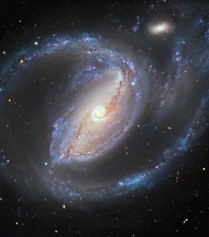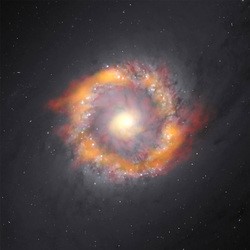July 17, 2015 by Steve Murray
Massive Measurement – Calculating the Size of Supermassive Black Holes

NGC 1097 observed in optical light
(ESO/R. Gendler)
Astronomers recently measured the mass of a supermassive black hole at the center of a galaxy located approximately 45 million light-years away.
They used a new technique and one of the highest observatories in the world – the Atacama Large Millimeter/submillimeter Array (ALMA). In the process, they expanded the set of tools needed to understand how black holes influence galaxy formation.
The heart of a galaxy
Supermassive black holes are gargantuan – millions of times the mass of the Sun. Astronomers now believe that there’s a supermassive black hole at the center of every large galaxy. Some studies have found that their mass is correlated to the mass and to the orbital speeds of the galaxies that surround them.
Recent observations, however, indicate the relationships between the mass of the black hole and the properties of its galaxy varies by the type of galaxy – elliptical, spiral, irregular, etc.
Determining the mass of these objects can refine our models of galaxy formation and evolution, but measuring them is no small task, especially for spiral and barred spiral galaxies.
Astronomers currently use several methods to determine the mass of supermassive black holes:
- Optical and infrared telescopes have been used to track star motions around the Milky Way galaxy to calculate the mass of the black hole at its center. This is only effective locally, however, when the stars are (relatively) close. More distant galaxies require angular resolutions that telescopes can’t achieve.
- Astronomers can also track the motions of megamasers in lieu of stars. Megamasers emit strong radio waves, are found near the centers of some galaxies, and can be easier to track. Unfortunately, they’re rare; the Milky Way, for example, has none.
- Ionized gas in a galaxy’s central bulge can also be used for tracking, but this technique works best when studying elliptical galaxies.
There aren’t really any good options, however, for measuring supermassive black holes in spiral galaxies.

ALMA radio telescope array (Steve Murray)
Another approach
Astronomers used a new, proof-of-concept method to measure the mass of the supermassive black hole at the center of NGC 1097 — a barred spiral galaxy in the direction of the constellation Fornax.
The researchers used the Atacama Large Millimeter/submillimeter Array, located high in Chile’s Atacama Desert, because it’s ideally suited for sensing the low frequency stellar signals they were most interested in. ALMA is an international astronomy facility, operated in a partnership of European Organisation for Astronomical Research in the Southern Hemisphere (ESO), the US National Science Foundation (NSF) and the National Institutes of Natural Sciences (NINS) of Japan in cooperation with the Republic of Chile. ALMA performs astronomical interferometry with an array of 66 coordinated radio telescopes.

ALMA data in green/orange (HCN) and red (HCO+), superimposed on optical image from the Hubble Space Telescope
(NRAO/ESO/NAOJ)
The research team measured the distribution and motion of two molecules with spectral lines in the millimeter range – hydrogen cyanide (HCN) and formylium (HCO+) – near the central region of the galaxy. Then, they compared their results to various mathematical models, each based on a different mass for its supermassive black hole.
The model that best fit their observations corresponded to a black hole weighing about 140 million solar masses (the mass of the Sun). For perspective, the black hole at the center of the Milky Way is just a few million solar masses.
Building on success
The new work, which was published in the June 2015 issue of Astrophysical Journal, tested an innovative method for studying spiral and barred spiral galaxies. Since current theories show that galaxies and their supermassive black holes evolve together, with each component affecting the growth of the other, the new technique could offer some important insights into the relationship between galaxies and their supermassive black holes.
And so, a new approach to studying distant objects has been added to the astronomer’s tool set. Future observations with ALMA will refine this method and likely expand its usefulness for studying other spiral-type galaxies.
